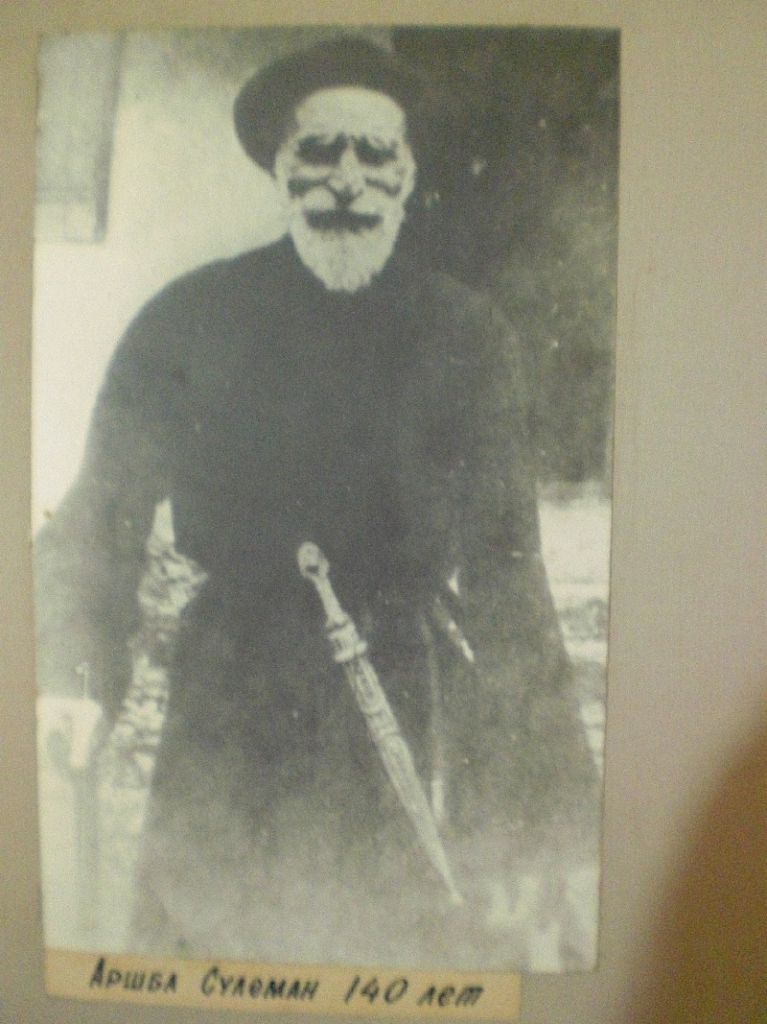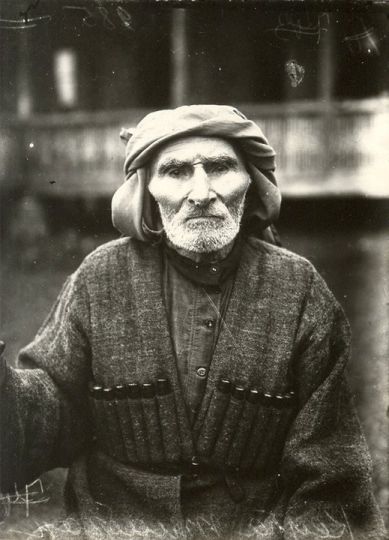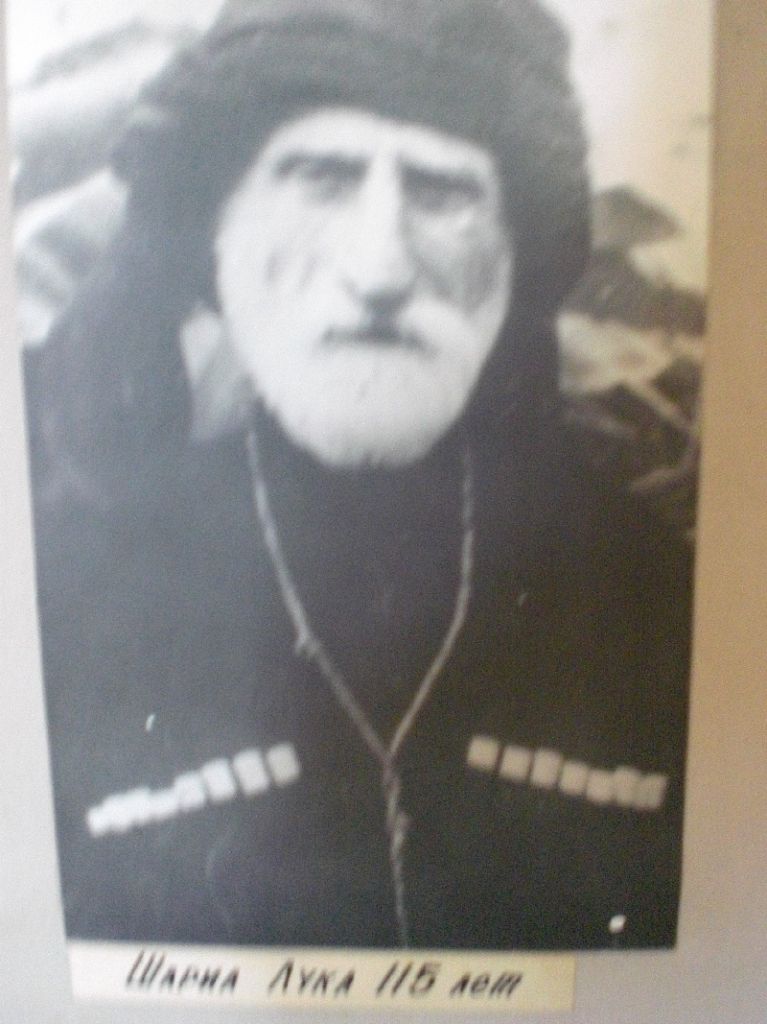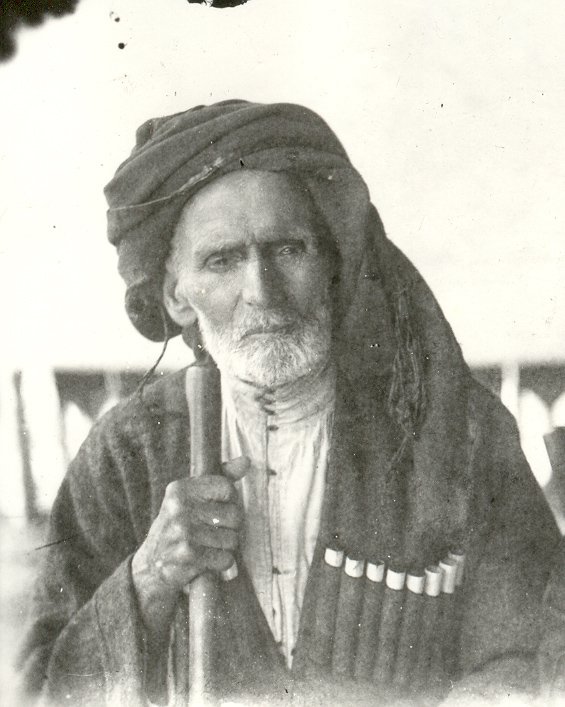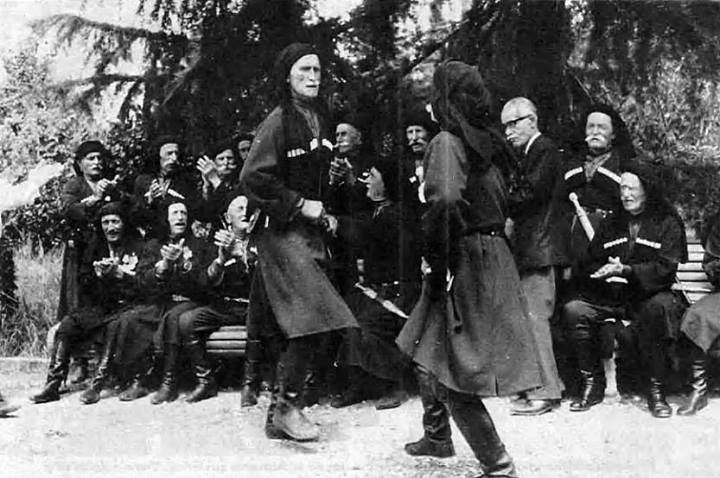Abkhazia: Ancients of the Caucasus (Healthy at 100), by John Robbins
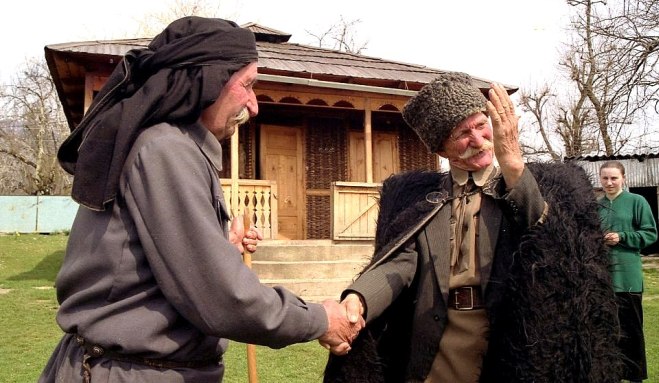
Why do some people age in failing health and sadness, while others grow old with vitality and joy?
In this revolutionary book, bestselling author John Robbins presents us with a bold new paradigm of aging, showing us how we can increase not only our lifespan but also our health span. Through the example of four very different cultures that have the distinction of producing some of the world's healthiest, oldest people, Robbins reveals the secrets for living an extended and fulfilling life in which our later years become a period of wisdom, vitality, and happiness. From Abkhasia [Abkhazia] in the Caucasus south of Russia, where age is beauty, and Vilcabamba in the Andes of South America, where laughter is the greatest medicine, to Hunza in Central Asia, where dance is ageless, and finally the southern Japanese islands of Okinawa, the modern Shangri-la, where people regularly live beyond a century, Robbins examines how the unique lifestyles of these peoples can influence and improve our own.
Bringing the traditions of these ancient and vibrantly healthy cultures together with the latest breakthroughs in medical science, Robbins reveals that, remarkably, they both point in the same direction. The result is an inspirational synthesis of years of research into healthy aging in which Robbins has isolated the characteristics that will enable us to live long and - most important - joyous lives. With an emphasis on simple, wholesome, but satisfying fare, and the addition of a manageable daily exercise routine, many people can experience great improvement in the quality of their lives now and for many years to come. But perhaps more surprising is Robbins' discovery that it is not diet and exercise alone that helps people to live well past one hundred. The quality of personal relationships is enormously important. With startling medical evidence about the effects of our interactions with others, Robbins asserts that loneliness has more impact on lifespan than such known vices as smoking. There is clearly a strong beneficial power to love and connection.
Chapter 1
People don't grow old. When they stop growing, they become old.
-Anonymous
In the early 1970s, National Geographic magazine approached the world-renowned physician Alexander Leaf, asking him to visit, study, and write an article about the world's healthiest and most long-living people. Dr. Leaf, a professor of clinical medicine at Harvard University and Chief of Medical Services at Massachusetts General Hospital, had long been a student of the subject and had already visited and studied some of the cultures known for the healthy lives of their elderly people. Now, National Geographic commissioned him to continue these travels and investigations and to share with the world his observations and comparisons of those areas of the planet which were famous for the longevity and health of their inhabitants. It was a time, unlike today, when these regions and their cultures were still somewhat pristine.
As a scientist, Dr. Leaf did not believe in a mythical fountain of youth in which anyone can bathe and be miraculously restored to eternal youth; nor did he believe in magic potions that can instantly heal all afflictions. But he did believe it was possible that there existed certain places on earth where people actually lived longer and healthier lives than is considered normal in the modern West. His goal was not to identify the oldest living individual, but rather to locate and study those societies - if they did in fact exist - where a large percentage of elder citizens retained their faculties, were vigorous, and enjoyed their lives. Rather than being interested in mythology or panaceas, his goal was to understand the key factors that influence human prospects for long and healthy life.
Dr. Leaf undertook a series of journeys that he subsequently described in an influential series of articles that appeared in National Geographic magazine beginning in 1973. His writings were among the first authoritative efforts to bring practical medical knowledge and research to our desire to know what we can do to impact the future of our lives.
When Dr. Leaf began his study and his travels, three regions of the world were famous for the longevity of their inhabitants: the valley of Vilcabamba in Ecuador, the Hunza region of Pakistan, and certain portions of the Caucasus mountains in what was then the Soviet Union. These three locales had long been the subject of claims that they were home to the longest living and healthiest people on earth. According to the stories swirling around these high mountainous regions, people in these communities often lived spectacularly long lives in vibrant health.
+ Outliving the Century: the story of a centenarian woman from Djgerda
+ Toast to Longevity: Gal Resident Celebrates 112th Birthday
+ Why They Live to Be 100, Or Even Older, in Abkhasia, by Sula Benet (1971)
Dr. Leaf and prizewinning National Geographic photographer John Launois traveled to these remote areas to meet, photograph, examine, and appraise for themselves the longevity and health of those who were reputed to be the world's oldest and healthiest people. Dr. Leaf listened to their hearts, took their blood pressure, and studied their diets and lifestyles. He watched them dance and saw them bathe in ice-cold mountain streams. He spoke with them about their daily lives, their hopes, their fears, their life histories. His goal was to separate fact from fallacy and determine the truth about longevity.
Longevity in Abkhasia [Abkhazia]
"Certainly no area in the world," Leaf wrote, "has the reputation for long-lived people to match that of the Caucasus in southern Russia." And in all the Caucasus, the area most renowned for its extraordinary number of healthy centenarians (people above the age of 100) was Abkhasia (pronounced "ab-KAY-zha"). A 1970 census had established Abkhasia, then an autonomous region within Soviet Georgia, as the longevity capital of the world. "We were eager to see the centenarians," Leaf said, "and Abkhasia seemed to be the place to do so."
Abkhasia covers three thousand square miles between the eastern shores of the Black Sea and the crestline of the main Caucasus range. It is bordered on the north by Russia, and on the south by Georgia.
How to live to be 100 [Abkhazian Longevity] | CBS Documentary by Morley Safer (1975).
Prior to Dr. Leaf's visit, claims had been widely circulated for life spans reaching 150 years among the Abkhasians [Abkhazians]. Just a few years earlier, Life magazine had run an article with photos of Shirali Muslimov, said to be 161 years old. In one of the photos, Muslimov was shown with his third wife. He told the reporter that he had married her when he was 110, that his parents had both lived to be over 100, and that his brother had died at the age of 134.
Muslimov had passed away by the time of Leaf's studies. But a woman named Khfaf Lasuria had also been featured in the Life article. Leaf wanted to meet her, and he found her in the Abkhasian village of Kutol, where she sang in a choir made up entirely, he was told, of Abkhasian centenarians.
I had a long talk with this diminutive - she stands not five feet tall - sprightly woman who claimed to be 141 years old. . . . Although she carried a handsomely carved wooden walking stick, her nimbleness belied need of it. Her memory seemed excellent. . . . She spoke lucidly and easily about events recent and past. At the age of 75 to 80 as a midwife she assisted more than 100 babies into the world. . . . She described the life of women: "Women had a very difficult time before the Revolution; we were practically slaves." And she ended our talk with a toast, "I want to drink to women all over the world . . . for them not to work too hard and to be happy with their families."
Though he was greatly impressed by this elderly lady's charm and spirit, Leaf did not simply take her word for her age. To the contrary, he went to significant efforts to assess it objectively. Such a task is harder than it might sound, for there are no signs in the human body, like the annual rings of a tree, that tell us a person's age.
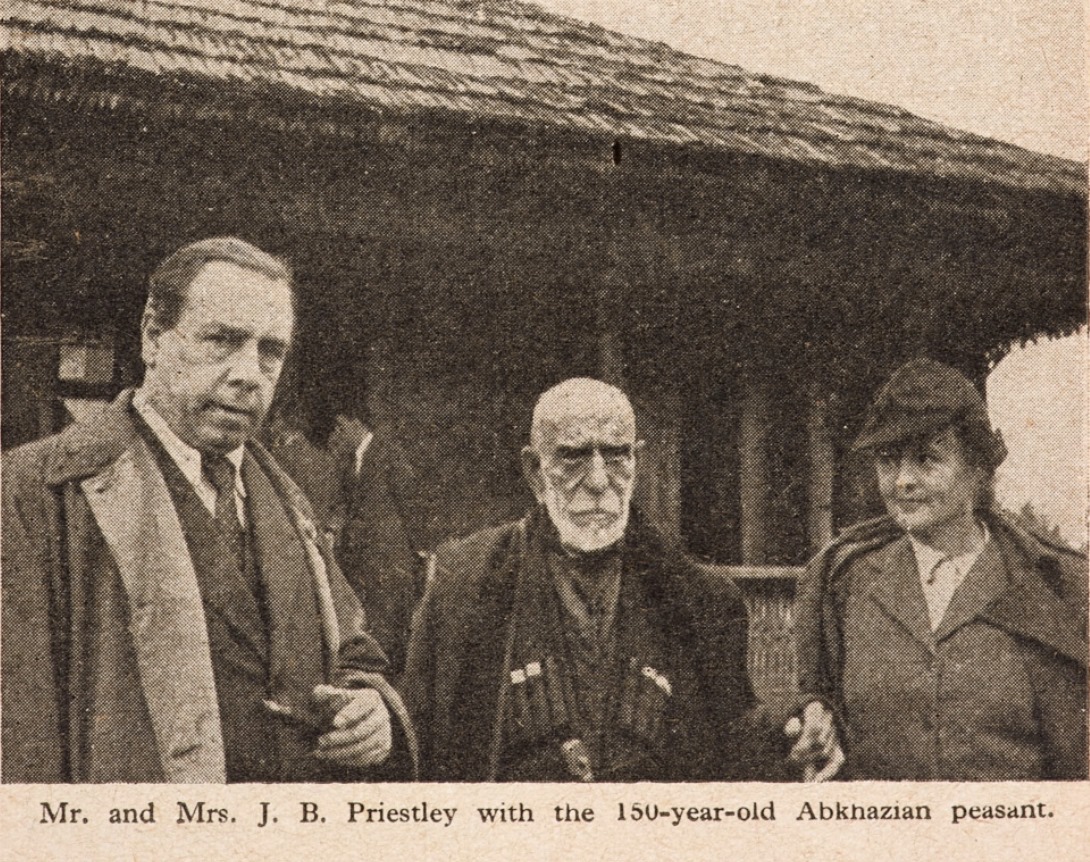
English playwright and novelist, John B. Priestley (1894 - 1984), his wife Jane Wyndham-Lewis and Ashkhangeri Bzhania (1945). Ashkhangeri Bzhania is one of the most famous supercentenarians in the history of Abkhazia.
John B. Priestley on Abkhazians. 'Russian Journey' by J B Priestley (1946).
After laborious investigations, Leaf concluded that Mrs. Lasuria was close to 130 years old. He wasn't certain about that, saying only that he had arrived at a degree of confidence and this was his best estimate. But he was sure of one thing. She was one of the oldest persons he had ever met.
Everywhere he went in Abkhasia, Leaf met elders in remarkable health. The area seemed to warrant its reputation as the mecca of superlongevity. Like others who have studied the elders of Abkhasia, Leaf had colorful stories to tell. He wrote of one elder, nearly 100, whose hearing was still good and whose vision was still superb.
"Have you ever been sick?" Leaf asked.
The elder thought for some time, then replied, "Yes, I recall once having a fever, a long time ago."
"Do you ever see a doctor?"
The old man was surprised by the question, and replied, "Why should I?"
Leaf examined him and found his blood pressure to be normal at 118/60 and his pulse to be regular at 70 beats per minute.
"What was the happiest period of your life?" Leaf asked.
"I feel joy all my life. But I was happiest when my daughter was born. And saddest when my son died at the age of one year from dysentery."
Among the others Leaf met were a delightful trio of gentlemen who, like many elderly Abkhasians, were still working despite their advanced age. They were Markhti Tarkhil, whom Leaf believed to be 104; Temur Tarba, who was apparently 100; and Tikhed Gunba, a mere youngster at 98. All were born locally. Temur said his father died at 110, his mother at 104, and an older brother just that year at 109. After a short exam, Leaf said that Temur's blood pressure was a youthful 120/84, and his pulse was regular at a rate of 69.
The old fellows clowned around constantly, joking and teasing each other and Leaf. While he was checking pulses and blood pressures the other two would shake their heads in mock sadness at the one being examined, saying "Bad, very bad!" They never seemed to tire of friendly joking, always finding new ways to have fun. Leaf was impressed by their sharp minds, high spirits, and relentless sense of humor.
Like many of the elders in Abkhasia, regardless of the weather, these men swam daily in cold mountain streams. One day, Leaf accompanied Markhti Tarkhil on his morning plunge and was astonished by the vitality and physical agility of the 104-year-old.9 It was a steep and rugged half-mile climb down from the road to the river, but Markhti moved with confident speed and agility. Seeing Markhti take off down the slope, Leaf, a physician coming from a society where elders have thin and fragile bones, was concerned that the older man might fall, and thought he should accompany Markhti down the hill and see to it that he didn't slip. But he was unable to do so, because he couldn't keep up with the pace of the far older man, who as it turned out never lost his footing. Later, Leaf learned from the regional doctor that there is no osteoporosis among the active elders, and that fractures are rare.
When Markhti arrived at the riverbank, he stripped and waded out into the stream, immersing his entire body in the cold water. A young guide Leaf had brought with him from Moscow also stripped and began wading into the water, but immediately jumped out, exclaiming that the water was far too cold.
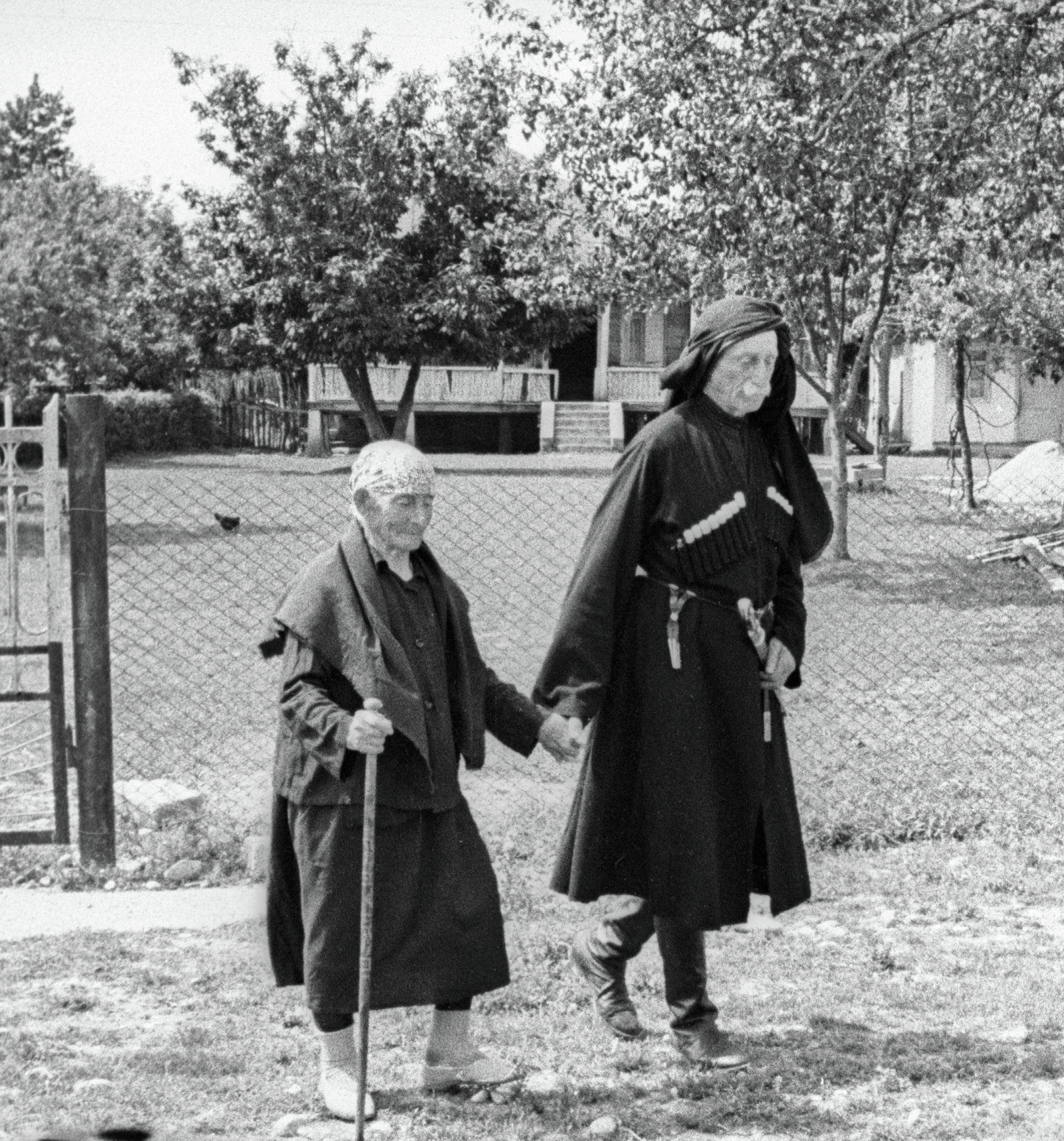
Khfaf Lasuria walks with her son. Khfaf Lasuria is one of the most famous supercentenarians in the history of Abkhaziz. She lived 137 years. See the CBS Documentary film about Kfaf Lasuria (February 2, 1975): https://bit.ly/32HNXP5
After bathing in the cold water for some time, Markhti got out, dried himself off, put on his clothes, and proceeded to climb swiftly back up the rugged slope, with Leaf, who was a half-century younger and who considered himself physically fit, once again struggling to keep up.
Are They Really That Old?
After Leaf's articles in National Geographic appeared, however, a heated controversy developed over the validity of the ages claimed by some Abkhasians. When people say they are 140 or 150 years old, this naturally raises eyebrows. When the Soviet press announced that Shirali Muslimov was 168 years old, and the government commemorated the assertion by putting his face on a postage stamp, knowledgeable scientists around the world were skeptical. There is a reason that, until recently, The Guinness Book of World Records introduced its section on longevity with the warning: "No single subject is more obscured by vanity, deceit, falsehood and deliberate fraud than the extremes of human longevity." Currently, the longest fully documented and irrefutably authenticated age ever reached by a human being is 122, by a Frenchwoman named Jeanne Louise Calment.
How old, in fact, are the oldest Abkhasians? No one knows with absolute certainty. In the days when these elders were born, probably less than one-tenth of 1 percent of the world's population was keeping written birth records. When birth records are lacking or questionable, as they are in almost all cases of people born prior to 1920 in regions like the Caucasus, contemporary researchers have had to be creative in developing methods to appraise the ages of elders. Many volumes have been written about the enterprising techniques that have been employed in the effort, and probably an equal number of scholarly volumes have been written critiquing these techniques. It has been a difficult task.
Probably the foremost skeptic about the extremely old ages sometimes claimed for elders in the Caucasus was a geneticist from Soviet Georgia named Zhores A. Medvedev, an expert in the methodologies used in the effort to arrive at accurate age verifications in Abkhasia and elsewhere in the Caucasus. Medvedev's articles expressing his doubts received a great deal of attention when they were published in the scientific journal The Gerontologist shortly after Leaf's articles appeared in National Geographic. (Gerontology is the study of the changes and associated problems in the mind and body that accompany aging.) In these articles, Medvedev presented convincing evidence that the claims that people were regularly living past the age of 120 were not to be trusted.10 At the same time, though, he recognized that unusual longevity in the region was a genuine reality, and that the area was indeed home to an inordinate number of extremely healthy elders.
As the controversy was unfolding, the legend of extraordinarily healthy and long-lived people in the Caucasus was being heavily promoted by U.S. corporations that manufactured and sold yogurt, attempting to connect the phenomenal longevity of people in the region to their consumption of yogurt. The Dannon yogurt company marketed a widely seen commercial showing a 110-year-old mother pinching the cheek of her 89-year-old son and telling him to eat his yogurt. This clever ad and others featuring Soviet centenarians were fabulously successful in the American market. They produced a generation of Americans who associated yogurt with extreme longevity, and who naïvely believed that people regularly lived to 140 and beyond in the Caucasus.

'Long livers from the Chlou village playing narde a version of backgammon.' Ochamchira, Abkhazia (August 1974).
Unfortunately, it was the inflated claims for supercentenarians living to extreme ages that got most of the attention in the 1970s and 1980s. What made Abkhasians so interesting to the Western world at the time was not their lifestyle and the wondrously healthy way they aged, but the exotic phenomenon of people supposedly living to unbelievable ages. When these extreme claims for superlongevity were found to be false, there was a regrettable tendency to dismiss everything about Abkhasian longevity as a hoax.
My interest in longevity in Abkhasia, however, doesn't depend on whether any specific individuals have reached ages beyond 120. Perhaps none have, but I don't find the question to be particularly important. What makes these people fascinating to me is the fact that an extraordinary percentage of Abkhasians have lived to ripe old ages while retaining their full health and vigor. What I find remarkable is the high degree of physical and mental fitness commonly found among the elders in Abkhasia, and their obvious joy in life.
About the Author
Widely considered one of the world's leading experts on the dietary link between the environment and health, John Robbins is the author of the million-copy bestseller Diet for a New America. His work has been the subject of cover stories and feature articles in the San Francisco Chronicle, Los Angeles Times, The Washington Post, The New York Times, and People. Robbins has been a featured and keynote speaker at hundreds of major conferences including those sponsored by the Sierra Club and UNICEF, and is the recipient of many awards, including the Rachel Carson Award and the Albert Schweitzer Humanitarian Award. He is the founder of EarthSave International, a nonprofit organization dedicated to healthy food choices, preservation of the environment, and a more compassionate world. Robbins lives with his wife, Deo, their son, Ocean, and daughter-in-law, Michele, and their grand-twins River and Bodhi outside of Santa Cruz, California.
Source: eNot Alone



